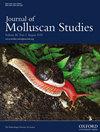论太平洋北方帽贝 Erginus (Problacmaea) puniceus Lindberg, 1988 的繁殖(腹足纲:罗网科)
IF 1.2
4区 生物学
Q2 MARINE & FRESHWATER BIOLOGY
引用次数: 0
摘要
五十年前,有报道称太平洋北方瓣鳃贻贝Problacmaea(=Erginus)的个体有一个用于交配的阴茎,并在掌腔中育雏。这些观察都是基于光镜,但现在我们通过电子显微镜揭示了Erginus (Problacmaea) puniceus生殖生物学的新细节。配子发生与其他腹足纲动物基本相似,但也有一些关键的不同之处。卵母细胞在身体后半部足背侧的卵巢中发育,然后通过输卵管进入掌腔,在那里受精并孵化。胚胎的发育是直接的,可育雏至爬行幼体阶段。不过,有时受精是在体内进行的,胚胎在生殖腺内或附近开始发育。在性腺中正在发育的卵母细胞附近发现了游离精子,这些精子很可能是自精子(自体),但也可能是异精子(异体)。精子发生的结果是形成内胚乳,内胚乳具有帽状顶体、子弹形细胞核和位于中段的球形线粒体。虽然没有观察到交配现象,但我们证实雄鱼的阴茎位于右侧头触角下方,具有背侧阴茎沟,这是某些软体动物功能性阴茎的典型特征。雄性个体总是较小,但中等大小的个体在不同程度上是雌雄同体的。最大的个体完全是雌性,它们的阴茎较小,通常没有阴茎沟。因此,E. (Problacmaea) puniceus似乎是一种原生雌雄同体动物,从雄性阶段过渡到雌性阶段。睾丸的残余一直持续到雌性阶段,这表明它们是具有重叠的原生雌雄同体动物,可能偶尔会发生自交。然而,最大的雌体没有任何睾丸残余,这表明该物种可能是原生顺序雌雄同体。本文章由计算机程序翻译,如有差异,请以英文原文为准。
On reproduction in the Pacific boreal limpet Erginus (Problacmaea) puniceus Lindberg, 1988 (Patellogastropoda: Rhodopetalidae)
Fifty years ago, it was reported that individuals of the Pacific boreal limpet Problacmaea (= Erginus) bear a penis for copulation and brood their young in the pallial cavity. These observations were based on light microscopy, but now we reveal new details of the reproductive biology of Erginus (Problacmaea) puniceus with electron microscopy. Gametogenesis is fundamentally similar to other Patellogastropoda, but there are some key differences. Oocytes develop in the ovary, dorsal to the foot in the posterior half of the body, before passing through the oviduct to the pallial cavity, where they are fertilized and brooded. Development is direct with embryos being brooded to the crawl-away juvenile stage. However, sometimes fertilization occurs internally with embryos beginning development in or near the gonad. Free sperm, which were likely autosperm (self) but could have been allosperm (cross), were found near developing oocytes in the gonad. Spermiogenesis results in the formation of an enta-quasperm with a cap-like acrosome, a bullet-shaped nucleus and spherical mitochondria in the midpiece. Copulation was not observed, but we confirm the presence of a penis with a dorsal penial groove that lies below the right cephalic tentacle in males, which is typical of functional penises of some molluscs. Males were always smaller, but intermediate-sized individuals were hermaphroditic to different extents. The largest individuals were entirely female, and their penises were smaller and often lacked the penial groove. Thus, E. (Problacmaea) puniceus appears to be a protandrous hermaphrodite, passing from male to female phase. Remnants of the testis persist into the female phase, suggesting that they are protandrous hermaphrodites with overlap, possibly allowing for self-fertilization to occur on occasion. However, the largest females lacked any testis remnants, suggesting instead that the species may be protandrous sequential hermaphrodites.
求助全文
通过发布文献求助,成功后即可免费获取论文全文。
去求助
来源期刊

Journal of Molluscan Studies
生物-动物学
CiteScore
3.00
自引率
8.30%
发文量
36
审稿时长
3 months
期刊介绍:
The Journal of Molluscan Studies accepts papers on all aspects of the study of molluscs. These include systematics, molecular genetics, palaeontology, ecology, evolution, and physiology. Where the topic is in a specialized field (e.g. parasitology, neurobiology, biochemistry, molecular biology), submissions will still be accepted as long as the mollusc is the principal focus of the study, and not incidental or simply a convenient experimental animal. Papers with a focus on fisheries biology, aquaculture, and control of molluscan pests will be accepted only if they include significant advances in molluscan biology. While systematic papers are encouraged, descriptions of single new taxa will only be considered if they include some ‘added value’, for example in the form of new information on anatomy or distribution, or if they are presented in the context of a systematic revision or phylogenetic analysis of the group.
 求助内容:
求助内容: 应助结果提醒方式:
应助结果提醒方式:


